As search engines continue to evolve, there are a variety of ways in which information can be provided to users. In particular, the SERP, or ‘search engine results page’ feature results are becoming more important for improving SEO performance, getting in front of your customers and ahead of your competitors.
A basic way to describe SERP features is that they are visual elements that provide multiple pieces of information which a user is able to research, designed to respond to search queries more effectively. Google uses the most relevant SERP features to present answers to user queries in a range of different formats on the results page. This allows users to explore and find what they need, in less time.
When it comes to finding SERP features, it is useful to know that they are much more prominent compared to traditional webpage listings and are generated based on Google’s ever-changing algorithm. Each SERP contains the highest-ranking and most appropriate website content related to the search query. Their unique information can sometimes provide users with everything they need without even having to visit a website.
In a nutshell, the ultimate goal of SERP features is to give the user the most relevant search results possible. By appearing in the SERPs, you are able to drive increased organic traffic and engagement.
Whether your site is on Shopify, Wordpress, Wix, Squarespace or other, there are plenty of ways a site can be optimised to increase its chances of appearing on SERP features. Here at Eastside Co, we have the best in-house experts to help you take your site to the next level with SERP feature rankings. But first, why not check out our insightful guide on what SERP features are and the different types you can appear for.
Most Common SERP Feature Types
SERP features are split into two separate categories, including paid and ‘earned’ organic placements and these are determined by Google’s algorithm. Every SERP has a group of different features which are displayed to meet the user’s search intent. Depending on the search queries entered by the user, the SERPs will show a variety of navigational, informational and transactional features.
Here is a breakdown on the most common organic SERP feature types.
1. Featured Snippets
A featured snippet is a short piece of text, highlighted within a box that appears at the top of Google. They are designed to help answer a user’s search query more efficiently and effectively.
The featured snippet is quality information related to a search query that Google has lifted from a webpage, so that the resource can be found by users more easily. Content shown inside a featured snippet is typically more concise and direct, with the aim to provide quicker answers to a user’s question.
According to a study by Ahrefs, featured snippets get approximately 8% of all organic clicks!
Most common types of featured snippets:
Definition Box - Usually found when searching a ‘what is’ query The Table - Data from a page inside a table which Google has pulled The List - Answer is broken down into a list with specific order - mostly used for step-by-step results.
Definition Box

The Table
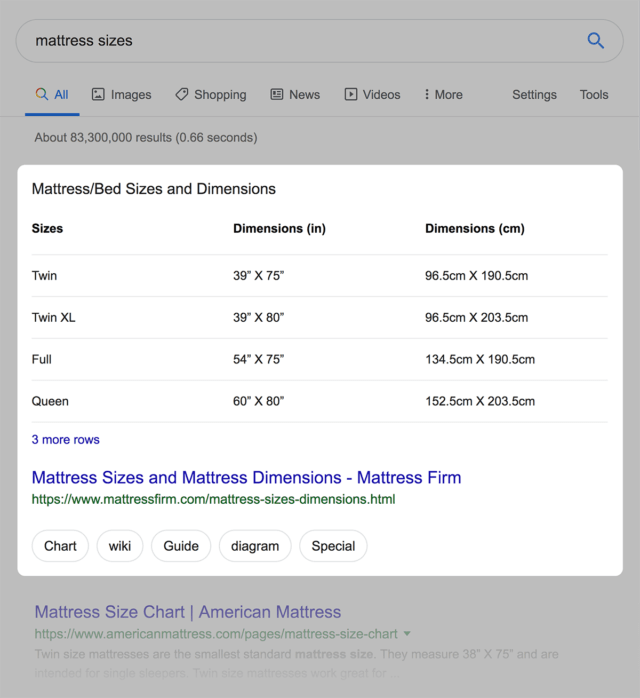
The List
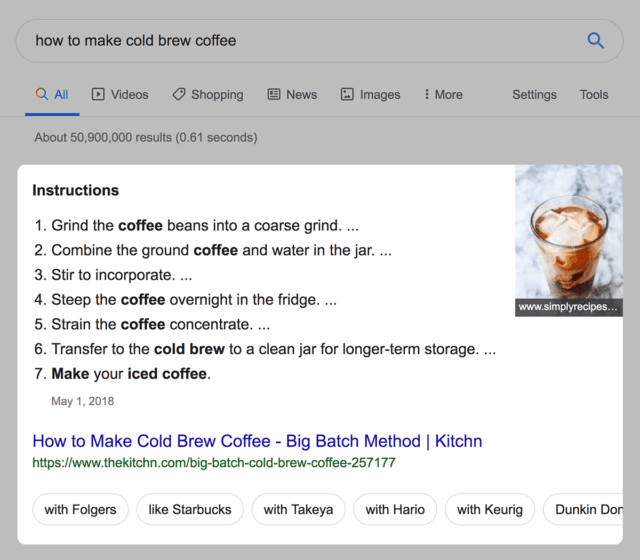
2. Knowledge Card vs Knowledge Panel
Another major SERP feature is the Knowledge Card. This SERP feature type can appear in a variety of formats, from a panel, box and a card. Typically found when searching for the weather or about a celebrity. They are known for containing a range of highly structured data as well as multiple images or videos. However, these results don’t often include any third-party links.
Knowledge Panel
A knowledge panel shows specific information, usually about people, places and organisations, which is lifted from high authoritative sources. They provide a more extensive answer about a certain topic a user has researched to save them clicking on for more details. They tend to appear to the right side of the organic results on desktop search. On mobile, they are shown directly under the ‘People also ask’ section or just above the ‘People also search for’ feature.
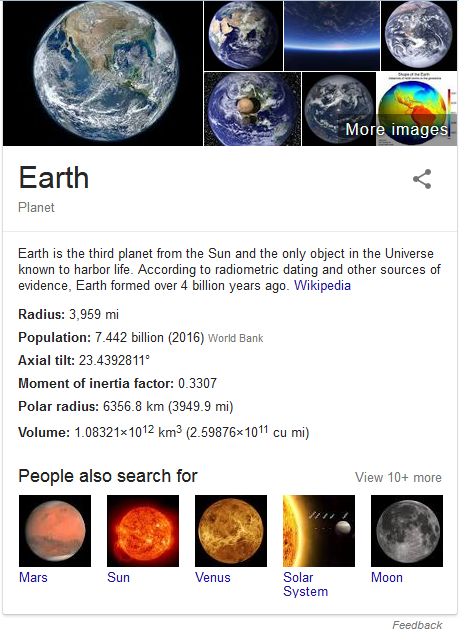
Knowledge Card
A knowledge card is found to the top left of a SERP and contains a brief overview relevant to a specific search query, either in data form or single sentences. The answers are pulled from the highest ranking site for the search query and can include images and a link to the original source of information.
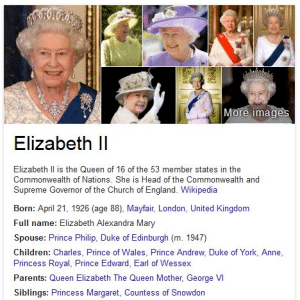
3. Image vs Video
The image pack and video pack SERP features allow users to explore the latest trending image and video content, relevant to their query topic. An image or video pack will appear if Google believes visual content will be most suitable for answering a user’s query. Media type search results are becoming increasingly popular as they help give users valuable information without them needing to visit Google images or the video tab.
Image Pack
An image pack appears as a horizontal row in the search engine results which contain a series of high-rated Google image links. These click through to individual images relevant to the user’s query. Google chooses to show an image pack when they believe visual content will be best for serving the user. The horizontal row can be positioned anywhere in the organic results.

Video Previews
If Google believes video content will benefit a user’s search query, they will sometimes display a Video Preview SERP feature. This contains a video title, video link, video thumbnail and a description all inside one box. The Video Preview recommends a clip that is in closest relation to a user’s query and is often generated from Youtube or in some cases from web pages which have their own video.

Video Carousel
A video will be shown if Google thinks the user will benefit from it. The videos may appear as a carousel or pack with a series of appropriate and relevant content to answer the user’s query. They can display a title, thumbnail and typically link to a hosting platform like Youtube or Web pages which have an embedded video. Videos will only appear in the SERPs for certain keywords.
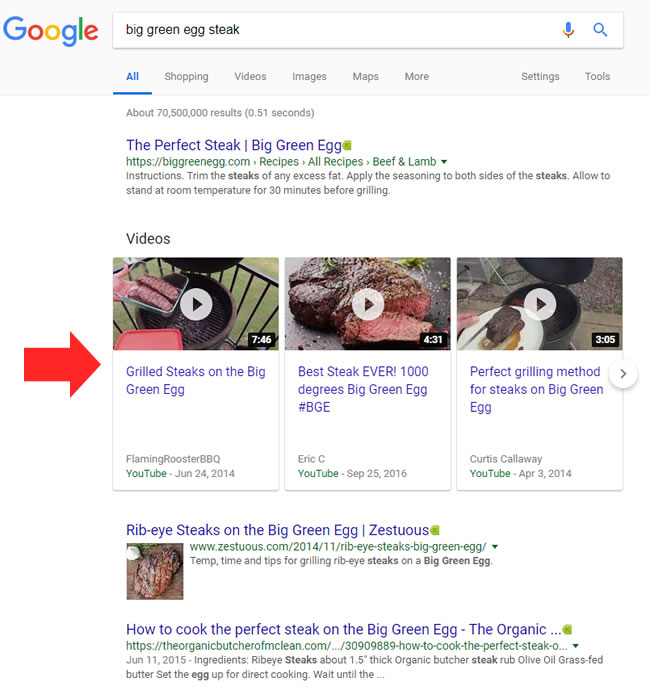
4. Local Pack
The local pack appears on the first page of organic results for any search query with a local intent, local service or geographical name e.g. ‘coffee shop near me’. A local pack contains a group of 3 related business listings, most relevant to the user’s query.
The business listings are pulled from the GMB directory and appear as a list format, with a map above to highlight the relevant area and provide a link to ‘more places’. Each business listing includes reviews, working hours, a physical address and a link to the company’s website.
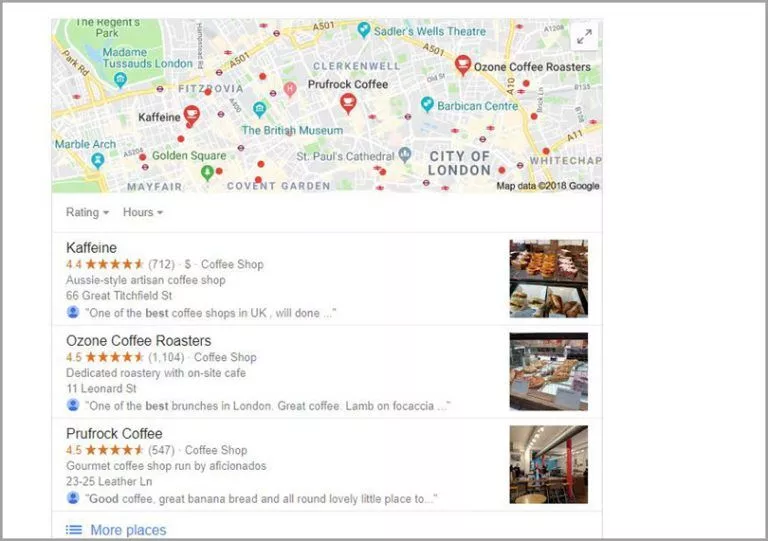
5. Sitelinks
Sitelinks appear below the main web result and are a group of separate links for one particular domain. The sitelinks support users in navigating your site and allows them to browse its different features which might interest them.
You will find sitelinks in only certain organic results and are shown as sub-listings under the first result in the search engines. They usually include between four and six links to the other web pages of the main URL. These will point to the most important sections of your website and provide users with a shortcut that saves them time, so they can find information more quickly.

6. In-Depth Articles
As one of the most difficult SERP features to identify, in-depth articles tend to be positioned at the bottom of the organic results and contain a block of three different articles. Their design provides additional context for users so they can understand their specific web page prior to clicking on it.
In-depth article features are typically reserved for higher rated content publishers, making it harder for other brands to appear there. An in-depth article feature will only show in organic results if a user’s search query requires detailed information. Google pulls specific articles which they believe the user might be trying to research.

7. Related Questions ('People Also Ask' & FAQs)
Google features related questions which are relevant to a user’s search. Their location in the search results can vary and when you click on each question, it expands into something that looks like a featured snippet. This allows users to find more information which could answer their next query before they have even researched it.
Typically, related questions are 30 words in length and aim to answer the most popular questions related to the main topic a user has searched. The related questions listed tend to also be keywords. The winner of the related question is the winner of the featured snippet that is shown. Additionally, the SERPs will only show algorithmically-generated questions.

8. Shopping Results
If Google detects a keyword with a transactional search intent, this can sometimes trigger a carousel of products that are able to be purchased. This is called the ‘Shopping Results’ SERP feature and each product is displayed as an AD which can come from multiple ecommerce sites.
The purpose of the ‘Shopping Results’ SERP feature is to allow people to browse through various products from a variety of brands more efficiently, without having to search other queries. It is also designed to help sell products more directly by providing images and prices. Shopping Results is mostly used when a query contains a product name and usually appears at the top of the SERPs.

9. Jobs
When a user searches for a specific job, Google will automatically display the latest relevant job listings available in the user’s location. The job listings will appear in a column at the top of the SERPs and each one contains job title, hiring company, location, the website which shows the original job post, how long the job has been open for, whether the job is full-time or part-time and if you have your home address saved to your Google account, you will be able to see the estimated commute time.
Users also have the ability to filter the job listings SERP feature to suit their needs. These can be based on category, title, location, date first advertised, full-time or part-time, industry and company name.

10. Twitter Boxes
Google will often display tweets within organic search results that appear as a row of boxes which can come from a brand or person. They only use the most recent and relevant tweets to a user’s search query to help provide them with real-time information. It also boosts the online presence of the brands who have tweeted.

11. App Pack
When user’s search for a particular type of app, Google will display a pack of the most relevant apps available to download which will benefit the user’s needs. These will usually appear on mobile or tablet search results and are shown inside a box at the top. If the app being searched for is a close match to one on the Google app store, then the more likely an App Pack will be shown. These will be applications which rank the highest on the app store. If a user clicks onto one of the apps in the SERP feature, it will immediately take the user to their devices app marketplace where they can install it.

Benefits of SERP feature rankings
By appearing in SERP feature rankings, this helps to significantly boost the organic traffic to your website. As a result, you’ll be able to generate more engagement and conversions through driving users to relevant pages on your website.
Overall, your site will have increased online visibility and you’ll be able to get in front of your competitors. Making it easier and quicker for users to find your website. A SERP feature ranking is also an effective way to improve your website’s credibility and authority level due to the fact that Google is recommending your website.
Why target SERP feature rankings?
- Increased organic traffic
- Boosted online presence
- Improved brand credibility
- Drive more conversions
- Get above your competitors
- Reach your target audience
Google Tests New SERP Feature
In this article we have mainly focused on outlining the most common SERP features but it is important that we mention about Google’s latest activity where it has been found to be testing a brand new SERP feature. In particular, Google has been focusing on different layouts and formats for the Featured Snippet feature. The first one it has tested out is the card style Google Featured Snippets and the second feature is a block and list view style of the Featured Snippet.
By making you aware of these potential SERP changes, you’ll be able to better prepare your website and reduce the impact it has on your traffic and conversions. Making sure your ranking page in the featured snippet is well optimised for the keyword you are targeting will be vital. The reason for this is that if more sources are shown in a Featured Snippet, this will decrease the value of your current Featured Snippet listing.
Card Style Featured Snippet

Block and list view of Featured Snippet
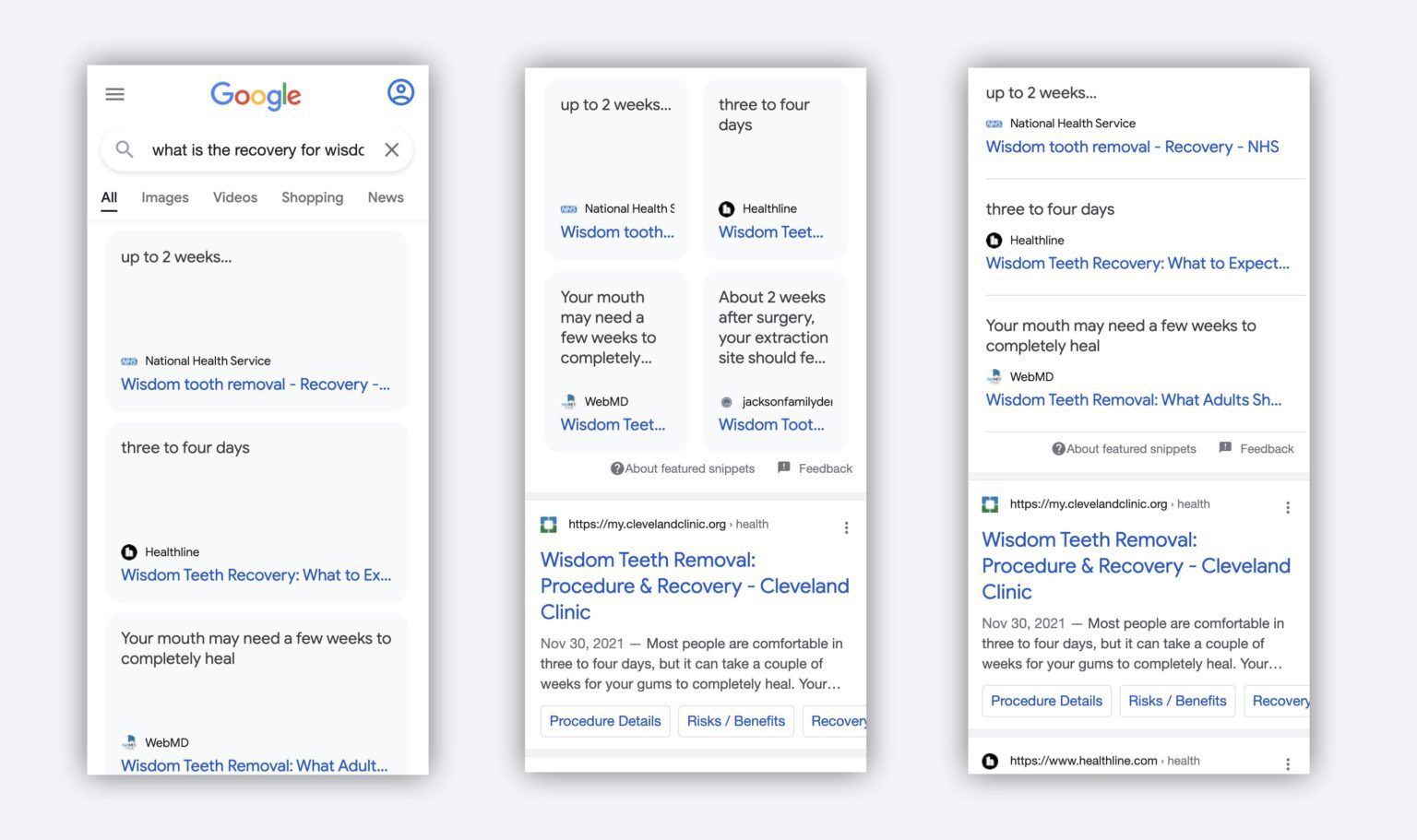
SERPs FAQs
How to feature as a SERP
It is important to understand what information the search engine needs to be able to rank your website in the SERP features. Each SERP feature will require different types of information, therefore you will need to ensure your website is optimised for the specific SERP feature you want to target.
The main method for featuring as a SERP is to create high quality, rich content that the search engines will be able to recommend. Rich content includes types of structured data that Google can use to respond to a user’s search query, such as reviews, recipes and events, product markup and video. By adding this content to your website, you will appear in the rich snippet SERP features.
Be sure to check what results are currently showing in the SERP features you want to target as this will give you tips on how to optimise your website.
For example, if you want to feature in the Frequently Asked Questions section, you will need to ensure the relevant page on your website answers those queries effectively. If Google finds that your website content is better, then it will replace the competitor's SERP link with yours.
How to find SERP feature opportunities
By using tools like SEMrush, Moz or Ahrefs, you can track new SERP feature opportunities for specific keywords in organic search. Most of the tools also allow you to discover what SERP features your site currently ranks for and what ones your competitors are ranking for. You do this by visiting Site Explorer and entering the competitor domain you want to check or you can find the SERP features
If you want to find what SERP features are available yourself, simply search for the keyword you are targeting in Google and you’ll find all of the SERP feature options you can optimise your site for. The typical ones include People Also Ask, Featured Snippet, Images and Videos.
We hope you have found our guide to SERP features valuable and that you now understand the clear advantages SERP feature rankings can achieve for your website. If you’re interested in learning more about SERP features in SEO or other ways to build your online presence, Eastside Co, the Shopify Experts, are on-hand to help. Simply get in touch with our friendly team, we’d love to hear from you!



